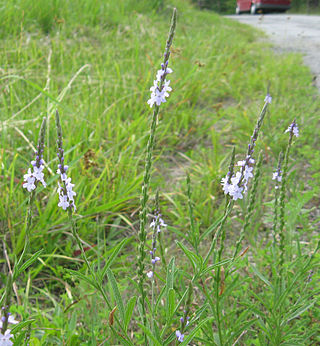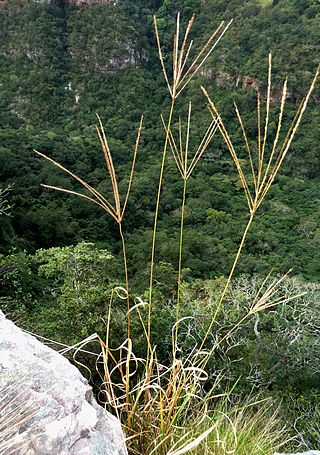
Adonis is a genus of about 20–30 species of flowering plants of the crowfoot family, Ranunculaceae, native to Europe and Asia.

Vigna aconitifolia is a drought-resistant legume, commonly grown in arid and semi-arid regions of India. It is commonly called mat bean, moth bean, matki or dew bean. The pods, sprouts and protein-rich seeds of this crop are commonly consumed in India. Moth bean can be grown on many soil types, and can also act as a pasture legume.

Sphagneticola trilobata, commonly known as the Bay Biscayne creeping-oxeye, merigold Singapore daisy, creeping-oxeye, trailing daisy, and wedelia, is a plant in the tribe Heliantheae of the family Asteraceae. It is native to Mexico, Central America, and the Caribbean, but now grows throughout the Neotropics. It is widely cultivated as an ornamental groundcover.

Echinacea atrorubens, called the Topeka purple coneflower, is a North American species of flowering plant in the family Asteraceae. It is native to eastern Kansas, Oklahoma, and eastern Texas in the south-central United States. It is found growing in dry soils around limestone or sandstone outcroppings and prairies.

Bromus hordeaceus, the soft brome, is an annual or biennial species of grass in the grass family (Poaceae). It is also known in North America as bull grass, soft cheat, and soft chess.

Arachis pintoi, the Pinto peanut, is a forage plant native to Cerrado vegetation in Brazil. It is native to the valleys of the upper São Francisco and the Jequitinhonha rivers of Minas Gerais. It has been named after the Brazilian botanist Geraldo Pinto, who first collected the plant at the locality of Boca do Córrego, município de Belmonte in 1954 and suggested its potential as a forage. The species has been first described by A. Krapovickas and W. Gregory in 1994.
Hopia obtusa is a species of grass commonly known as vine mesquite. This plant was treated as Panicum obtusum until recently when more molecular and genetic material revealed new information about it. Hopia obtusa is now placed in the monotypic genus Hopia.

Boerhavia erecta, commonly known as the erect spiderling or the erect boerhavia, is one of more than 100 species in the genus Boerhavia L. Boerhavia erecta is native to the United States, Mexico, Central America, Angola and western South America, but now is cosmopolitan in tropical and subtropical regions. In Africa its distribution extends from West Africa, eastwards to Somalia and down to South Africa. It has recently been found in parts of Madagascar and Réunion. In Asia, it occurs in India, Java, Malaysia, the Philippines, China and the Ryukyu Islands.

Alysicarpus vaginalis is a species of flowering plant in the legume family, Fabaceae. It is native to parts of Africa and Asia, and it has been introduced to other continents, such as Australia and the Americas. It is cultivated as a fodder for livestock, for erosion control, and as a green manure. Common names include alyce clover, buffalo clover, buffalo-bur, one-leaf clover, and white moneywort.

Verbena simplex, commonly known as narrowleaf vervain, is a perennial herbaceous plant plant in the Verbenaceae (vervain) family. It is native to central and eastern North America where it is found in open, dry, habitats on calcareous soil. It produces lavender flowers in the summer.

Digitaria eriantha, commonly known as digitgrass or Pangola-grass, is a grass grown in tropical and subtropical climates. It grows relatively well in various soils, but grows especially well in moist soils. It is tolerant to droughts, water lodging, suppresses weeds and grows relatively quickly after grazing. This grass demonstrates great potential for farmers in Africa in subtropical and tropical climates, mostly for livestock feed.

Centrosema brasilianum belongs to the dicot class with a variety of names such as Clitoria brasiliana, and many more. It is a member of the family Fabaceae. This species in mainly found in South American nations such as Brazil, Guyana, and Bolivia.

Cadaba aphylla ("Swartstorm") is one of the many species in the genus Cadaba. It is indigenous to southern Africa.

Vigna luteola, commonly known as the hairy cowpea and the Nile bean, is a perennial vine found in many tropical areas.

Vigna hosei, also known as the sarowak bean, is a perennial legume that grows in low-lying, humid, tropical areas but more commonly disturbed or roadside areas.

Vigna parkeri, the creeping vigna or vigna menjalar, is a climbing or prostrate perennial vine that grows in subtropical areas such as Kenya, Indonesia, and Madagascar.
Hypericum cuisinii is a perennial herb in the genus Hypericum, in the section Adenosepalum. The herb has pale yellow flowers and occurs in Greece and Turkey.
Puccinellia laurentiana is a perennial grass which grows on gravelly seashores in south-eastern Canada. Its specific epithet "laurentiana" refers to the Gulf of St. Lawrence, where it grows.

Asclepias perennis, also known as aquatic milkweed or white swamp milkweed, is a North American species of milkweed that is found throughout the Coastal Plain from eastern Texas to southern South Carolina, northward along the Mississippi River, and into the Ohio Valley of Illinois, Indiana, and Kentucky. There seems to be a few disjunct populations in Arkansas, Texas, and Indiana.
Gutenbergia rueppellii is an African species of flowering plant in the family Asteraceae.
















